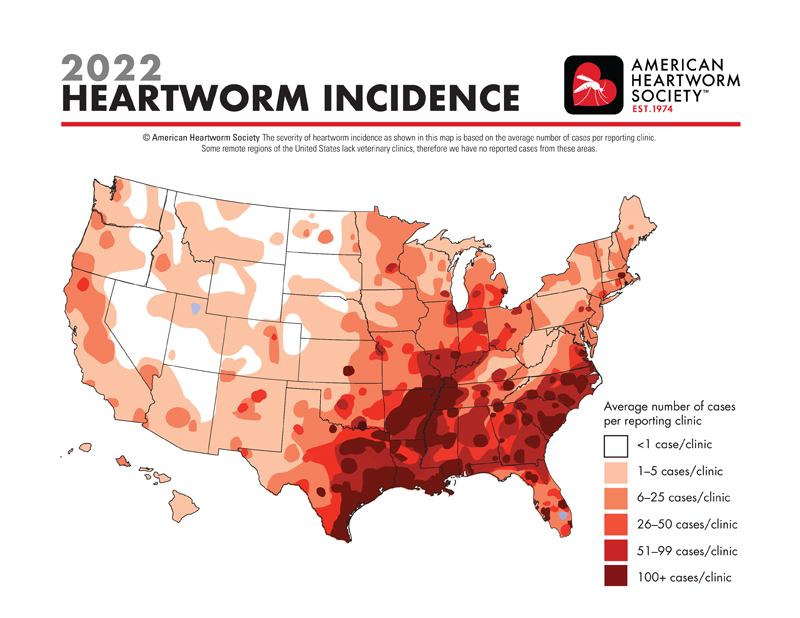
Photo courtesy AHS
An influx of heartworm-positive dogs across the U.S. and a general lack of prevention compliance are the driving factors behind the uptick in heartworm cases.
This is according to the American Heartworm Society (AHS). The group has unveiled its 2022 Heartworm Incidence Map, drawn from data provided by thousands of veterinary practices and shelters across the U.S.
The numbers show the locales with highest heartworm incidence continue to be those in and adjacent to the lower Mississippi Delta, AHS reports. These areas typically experience conditions fostering widespread heartworm infection, including, among other factors, a mosquito-heavy climate.
“The states with the highest density of diagnosed heartworm cases in the latest survey were Mississippi, Louisiana, Texas, Alabama, and Arkansas,” says AHS president Jennifer Rizzo, DVM. “Meanwhile, Arkansas, Mississippi, Texas, Georgia, Florida, Tennessee, and the Carolinas all saw expansions of high-density areas on our incidence map.”
Additionally, the report shows “unexpected increases” in incidence for states with historically low heartworm rates, including Washington, Oregon, Kansas, North Dakota, Massachusetts, and Connecticut. These areas also saw the development of new “hot spot” areas within their borders.
Further, several urban cities (including Seattle, Wash., and Boise, Idaho, in the Northwest; Bismarck, N.D., in the Upper Midwest; and Tucson, Ariz., in the Southwest) saw significant increase in heartworm rates.
While no single reason can be attributed to these changes, AHS speculates an influx of heartworm-positive animals from out-of-state, higher testing rates, and a lack of prevention compliance may play a role, highlighting the valued rule veterinarians play in discussing heartworm risk with clients.
“Whether it’s educating new pet owners about heartworm prevention or reminding long-time owners of its importance, it’s clear the AHS and the veterinary profession must work together to continue to work together to raise awareness of this devastating disease,” Dr. Rizzo says.
In addition to reporting their heartworm incident numbers, respondents were also asked about trends noted since the previous AHS survey was conducted in early 2020. Specifically, practitioners were asked whether heartworm rates in their area had stayed the same, increased, or decreased in this time.
Findings reveal:
- While half of respondents (53 percent) reported stable heartworm rates, significantly more respondents said rates had increased (29 percent) than decreased (17 percent).
- Among those who saw rates rise, nearly one-third (32 percent) attributed this to the influx of heartworm-positive pets to their area. Poor compliance with heartworm prevention (27 percent) followed closely, along with weather conditions that caused an increase in mosquitoes (22 percent).
- Among respondents who saw heartworm rates drop, changes in pet-owner behavior, including increases in pet owners administering heartworm preventives (33 percent) and improvements on preventive compliance (31 percent), were the most cited reasons.
AHS conducts its heartworm incidence survey every three years by asking veterinary practices and shelters to voluntarily submit data from heartworm antigen tests run over the course of the previous year. The latest survey was conducted in early 2023 and reflects data from heartworm testing conducted throughout 2022.
“While the past three years have been tumultuous for both the veterinary profession and our clients, the good news is heartworm disease continues to be almost 100 percent preventable with faithful year-round heartworm prevention,” Rizzo says.
To view the 2022 heartworm incidence map, click here.
